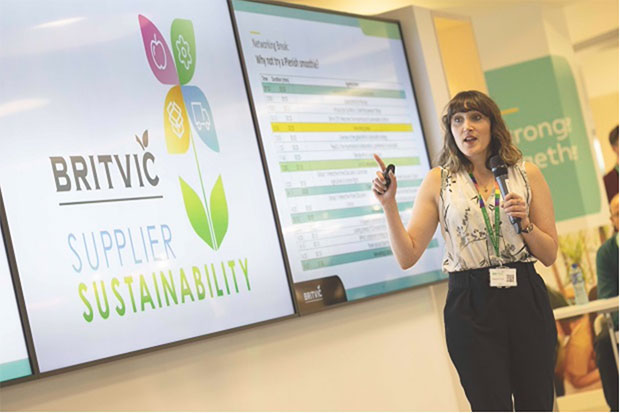The number of corporates setting net-zero targets has risen by more than 40%, from 700 in June 2022 to 1,003 in November 20231.
 This rapid increase in target-setting comes in response to the growing recognition of climate change, coupled with an increase in energy cost volatility.
This rapid increase in target-setting comes in response to the growing recognition of climate change, coupled with an increase in energy cost volatility.
Such targets mean many businesses are scrambling to find appropriate solutions to drive down their carbon emissions while also being financially viable.
The latter factor is becoming increasingly significant, with members of the Business Advisory Group reporting that one of the key barriers to investment into Net Zero solutions was uncertainty over long-term funding availability2, writes Gurpreet Gujral, Managing Director, Renewable Energy at Atrato Group.
Learning curve
There is no silver bullet for corporate carbon reduction. Businesses in the food and grocery space typically possess large sites with ranks of refrigeration units running day and night, driving among the highest energy intensities of any commercial business. This makes them ideal candidates for onsite solar energy. Not only do high energy requirements contribute to greater carbon emissions if energy is not renewably sourced, but they can also be costly: a typical superstore’s annual electricity bill can easily hit seven figures. Working with providers who fund, install and manage onsite solar energy could allow grocers to significantly reduce their electricity bills.
Nevertheless, despite these benefits driving resilient demand for solar power, with 303MW of commercial solar being installed between January and November 20233, there is still a lack of understanding when it comes to the economics of the technology. A recent government report found this to be one of the largest barriers to the installation of solar for medium sized businesses. Companies looking to take further steps on the road to net zero, should examine the different ways onsite solar can meet businesses’ specific requirements.
Onsite comes online
The most common way to incorporate solar and reduce business carbon emissions, is by installing solar panels on roofs or adjacent land and connecting the power directly, referred to as private wire power purchase agreements. One example of this approach is the work Atrato Onsite Energy is doing with Tesco to provide solar power to its stores across the country.
The most recent project is a rooftop solar array on a Tesco supermarket in Thetford. After analysing historic annual energy usage data to design the system, over 1,100 solar panels were installed with a total capacity of 370kWp, at no upfront cost to Tesco. Tesco benefits from clean and traceable energy that is generated on the store’s rooftop for the term of the 20-year power purchase agreement (PPA) at a significantly lower price than energy from the grid. This can be as low as 12p per kWh, versus a grid price of 28p, according to recent analysis from Stifel investment bank.4
In a bid to achieve its 2030 net zero emissions goal, late last year Tesco announced plans to install solar at 100 further stores over the next three years. The Thetford site is one of 19 stores that Atrato Onsite Energy has partnered with Tesco to supply energy to.
While Tesco is taking this more localised or store-level approach to solar panel installation, other companies are reaping the benefits of onsite solar generation on large sites like distribution centres. Another Atrato Onsite Energy site is the 6MW rooftop solar PV system situated atop Marks & Spencer’s 900,000 square foot distribution centre in Leicestershire. Equivalent to 11 Wembley size football pitches, it was the largest rooftop solar system in the UK when installed, with 24,000 solar panels. This M&S example again demonstrates how companies can shield their bottom line from volatile energy prices, while cutting emissions, all without initial capital outlay.
Sleeves rolled out
While many British food and grocery companies have expressed a strong desire to implement onsite solar power, certain constraints may impede their ability to do so. Limitations stemming from factors such as the size of their roof space, available surrounding land or unsuitability due to elements such as building shading are just some examples. In these situations, an alternative option known as a sleeved power purchase agreement, or PPA, may offer a solution. This sells electricity from a dedicated offsite renewable project to a consumer, at a fixed price, through an intermediary connection.
Britvic, the FTSE 250 producer of soft drinks, signed such a 10-year agreement with Atrato Onsite Energy in July 2023 for the energy produced by a 28MW solar farm in Northamptonshire. The energy generated is “sleeved” via the power grid. The 10-year commitment to underwrite the site’s energy generation allowed Atrato to make a £28m upfront capital investment to build the site. In doing so, Britvic’s PPA provides incremental clean energy to the country’s energy mix, termed ‘additionality’.
This 28MW solar farm will be capable of generating 33.3GWh of clean energy every year, enough to power 75% of Britvic’s operations in Great Britain, or the equivalent to powering 12,300 homes. The deal saves Britvic 6,500 tonnes of CO2 emissions each year, with 100% carbon traceability, propelling the soft drinks producer towards its goal of net zero carbon emissions by 2050. As the first UK soft drinks company to have a 1.5°C target verified by the Science Based Targets initiative, this all helps Britvic maintain its industry bellwether status.




Comments are closed.